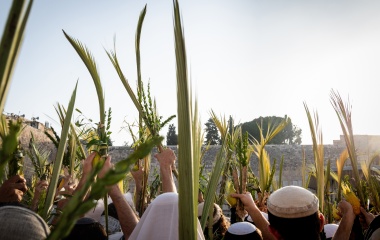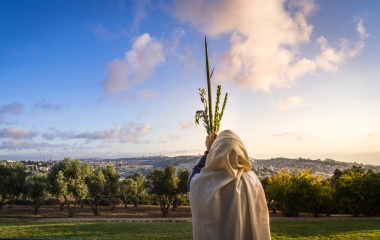
As important (if not more so) as what one says is how it is said, when it is said, and what is not said. This is equally true regarding both our interactions with other people and our religious texts. Form is as important as substance. So much of Jewish law is derived by looking at form over substance, the 39 forbidden activities of Shabbat being just one of many examples[1].
When it comes to our sacred texts, there is no one more adept at the use of form (and, for that matter, substance) than the Rambam. His style of classification, use of language, ability to seamlessly weave together so many disparate sources, and clarity are unmatched and the source of endless study—and this, before we even address his philosophical writings.
In classifying the Jewish holidays, we tend to group Rosh Hashanah and Yom Kippur together. “On Rosh Hashanah it is written and on Yom Kippur it is sealed”. There are a number of prayers said on these three days only, with others said only during the Aseret Yemei Teshuva. Our Rabbis suggest that G-d is closer during the period between Rosh Hashanah and Yom Kippur, and it is those two holidays alone that are called Yamim Noraim, “the Days of Awe”.
Yet fascinatingly, the Rambam links Rosh Hashanah not with Yom Kippur, but with Sukkot. In “The Laws of Shofar, Sukkah and Lulav", the first three chapters discuss the laws of shofar, chapters four through six discuss the laws of sukkah, and chapters seven and eight, the laws the arba minim, the four species. Apparently, the lulav and the shofar are more closely connected than first meets the eye[2].
Unlike the Rambam, the Shulchan Aruch codifies the laws of the holidays by simply following the calendar, beginning with Pesach and ending with the laws of Purim. But that does not prevent the Shulchan Aruch from linking various holidays. Paralleling the Torah’s description of Shavuot, the Shulchan Aruch codifies the laws of Shavuot within the laws of Pesach, Shavuot being the 50th day and culmination of the Passover holiday.
Moreover, the very last “law” of Yom Kippur codified in the Shulchan Aruch is, “And the meticulous ones begin immediately on motzei Yom Kippur to build the sukkah so that they may go from one mitzvah to another”.
Yet rather redundantly, the very next halacha—the first in the laws of Sukkot—states, “And it is a mitzvah to begin building the sukkah immediately after Yom Kippur. For a mitzvah that comes to one's hands, one should not delay performing it” (Orach Chaim, 625).
Putting these two halachot back-to-back seems to be little more than needless repetition. But if one looks not at the substance but the form, there is much to learn. The law that the meticulous ones build a sukkah on motzei Yom Kippur has little to do with Sukkot and much to do with Yom Kippur.
Much more important than what we do on Yom Kippur is what we do after Yom Kippur. If we are no different on the 11th of Tishrei than on the ninth, the tenth had little meaning. And Judaism teaches that meaning is found in mitzvot. We may eat at nightfall, but the sanctity of Yom Kippur must extend well beyond that. The laws of Yom Kippur urge us to begin building our sukkah, because we must go “from mitzvah to mitzvah.”
And yet with Yom Kippur over, we turn our attention to Sukkot. And when opening the Shulchan Aruch, we read that we must build a sukkah at the earliest opportunity, which happens to be motzei Yom Kippur. Having been busy the last few weeks, Sukkot has taken a back seat. But with Yom Kippur over, one can focus on Sukkot and thus, it is now time to build a sukkah; "a mitzvah that comes to one's hands, one should not delay performing it".
Perhaps we might suggest that these “two” sukkot, that of Yom Kippur and that of Sukkot, reflect the two Talmudic reasons given for the mitzvah. The clouds of glory that protected the Jewish people in the desert symbolize the sukkah of Yom Kippur, the day that has the potential to “protect” us from punishments, and the sukkah of Sukkot reflects the actual huts in which the Jewish people dwelled in the desert.
This is all very nice—until one realizes that there is, in fact, no mitzvah to build a sukkah. The mitzvah is to dwell in a sukkah, not to build it. There is no bracha made when we build the sukkah, and the Talmud specifically allows non-Jews to build a sukkah, something that would not be possible if building the sukkah was actually a mitzvah[3].
Building a sukkah may not be a mitzvah, but it is a heksher mitzvah, a preparatory act that allows one to fulfil the mitzvah of sukkah. And that is exactly the point. Yom Kippur must inspire us not only to do what we have to do, but to do anything and everything connected to mitzvot. Preparing for a mitzvah can be of greater importance and have a greater impact than the mitzvah itself. One who is excited to go to a baseball game does not show up when the game starts. One comes early, hoping to catch some batting practice and perhaps get a few autographs. We build a sukkah not because we have to, but because we want to. We look to literally wrap oursleves in mitzvoth.
On Yom Kippur we are to purify ourselves before G-d, lifnei Hashem tetharu. But on Sukkot, we are to rejoice before G-d, u’smachtem lifnei Hashem. When one does mitzvot because one must, there is little joy in doing what we do. Those who are able to worship G-d b’simcha, with joy and excitement, are truly blessed.
[1] The undefined prohibition to “work” on Shabbat is juxtaposed next to the command to build a Mishkan, leading our Sages to define work as those 39 activities needed for the building (or the running) of the Mishkan.
[2] What that connection might be is something I discuss here.
[3] This could explain why these two halachot are not mentioned by Rav Yosef Karo in the original text of the Shulchan Aruch but appear in the glosses of the RaMaH, which have been incorporated into the Shulchan Aruch.



